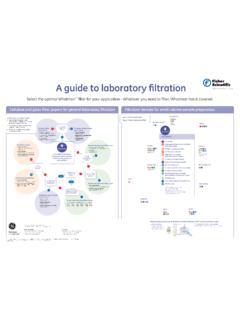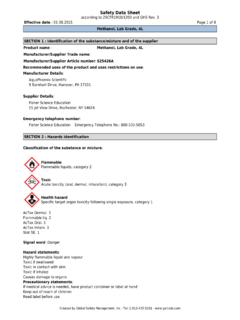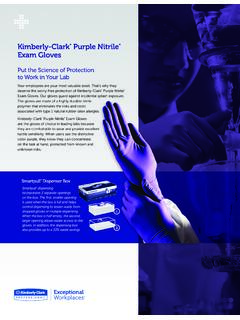Transcription of Safety Data Sheet - Fisher Sci
1 Safety data Sheet according to 29 CFR1910/1200 and GHS Rev. 3. Effective date : Page 1 of 7. Sodium Acetate,Anhydrous, SECTION 1 : Identification of the substance/mixture and of the supplier Product name : Sodium Acetate,Anhydrous, Manufacturer/Supplier Trade name: Manufacturer/Supplier Article number: S25530. Recommended uses of the product and uses restrictions on use: Manufacturer Details: AquaPhoenix Scientific 9 Barnhart Drive, Hanover, PA 17331. Supplier Details: Fisher Science Education 15 Jet View Drive, Rochester, NY 14624. Emergency telephone number: Fisher Science Education Emergency Telephone No.
2 : 800-535-5053. SECTION 2 : Hazards identification Classification of the substance or mixture: Not classified for physical or health hazards under GHS. Hazards Not Otherwise Classified - Combustible Dust Hazard statements: Precautionary statements: If medical advice is needed, have product container or label at hand Keep out of reach of children Read label before use Do not eat, drink or smoke when using this product Combustible Dust Hazard: : May form combustible dust concentrations in air (during processing). Other Non-GHS Classification: WHMIS.
3 NFPA/HMIS. NFPA SCALE (0-4) HMIS RATINGS (0-4). SECTION 3 : Composition/information on ingredients Created by Global Safety Management, Inc. -Tel: 1-813-435-5161 - Safety data Sheet according to 29 CFR1910/1200 and GHS Rev. 3. Effective date : Page 2 of 7. Sodium Acetate,Anhydrous, Ingredients: CAS 127-09-3 Sodium Acetate, Anhydrous, ACS 100 %. Percentages are by weight SECTION 4 : First aid measures Description of first aid measures After inhalation: Move exposed individual to fresh air. Loosen clothing as necessary and position individual in a comfortable medical advice if discomfort or irritation breathing difficult, give oxygen.
4 After skin contact: Wash affected area with soap and water. Rinse/flush exposed skin gently using water for 15-20 minutes. Seek medical advice if discomfort or irritation persists. After eye contact: Protect unexposed eye. Rinse/flush exposed eye(s) gently using water for 15-20 minutes. Remove contact lens(es) if able to do so during rinsing. Seek medical attention if irritation persists or if concerned. After swallowing: Rinse mouth thoroughly. Do not induce vomiting. Have exposed individual drink sips of water. Seek medical attention if irritation, discomfort or vomiting persists.
5 Most important symptoms and effects, both acute and delayed: Irritation, Nausea,Headache, Shortness of breath.;. Indication of any immediate medical attention and special treatment needed: If seeking medical attention, provide SDS document to physician. SECTION 5 : Firefighting measures Extinguishing media Suitable extinguishing agents: Water spray. Dry chemical powder. Carbon dioxide. Alcohol foam. Polymer foam. If in laboratory setting, follow laboratory fire suppression procedures. Use appropriate fire suppression agents for adjacent combustible materials or sources of ignition For Safety reasons unsuitable extinguishing agents: Special hazards arising from the substance or mixture: Combustion products may include carbon oxides or other toxic decomposition can lead to release of irritating gases and generating dust; fine dust dispersed in air in sufficient concentrations, and in the presence of an ignition source is a potential dust explosion hazard.
6 Advice for firefighters: Protective equipment: Use NIOSH-approved respiratory protection/breathing apparatus. Additional information (precautions): Move product containers away from fire or keep cool with water spray as a protective measure, where spark-proof tools and explosion-proof equipment. SECTION 6 : Accidental release measures Personal precautions, protective equipment and emergency procedures: Wear protective equipment. Transfer to a disposal or recovery spark-proof tools and explosion- proof respiratory protective device against the effects of fumes/dust/aerosol.
7 Keep unprotected persons away. Ensure adequate away from ignition sources. Protect from the spill, if possible. Contain spilled material by diking or using inert absorbent. Environmental precautions: Prevent from reaching drains, sewer or waterway. Collect contaminated soil for characterization per Section 13. Methods and material for containment and cleaning up: Created by Global Safety Management, Inc. -Tel: 1-813-435-5161 - Safety data Sheet according to 29 CFR1910/1200 and GHS Rev. 3. Effective date : Page 3 of 7. Sodium Acetate,Anhydrous, If in a laboratory setting, follow Chemical Hygiene Plan into properly labeled containers for recovery or disposal.
8 If necessary, use trained response deposits should not be allowed to accumulate on surfaces, as these may form an explosive mixture if they are released into the atmosphere in sufficient concentration. Avoid dispersal of dust in the air ( , clearing dust surfaces with compressed air). Collect solids in powder form using vacuum with (HEPA filter). Reference to other sections: SECTION 7 : Handling and storage Precautions for safe handling: Minimize dust generation and accumulation. Wash hands after handling. Avoid dispersal of dust in the air ( , clearing dust surfaces with compressed air).
9 Routine housekeeping should be instituted to ensure that dusts do not accumulate on surfaces. Dry powders can build static electricity charges when subjected to the friction of transfer and mixing operations. Follow good hygiene procedures when handling chemical materials. Do not eat, drink, smoke, or use personal products when handling chemical substances. If in a laboratory setting, follow Chemical Hygiene only in well ventilated generation of dust or fine contact with eyes, skin, and clothing. Conditions for safe storage, including any incompatibilities: Store in a cool location.
10 Provide ventilation for containers. Avoid storage near extreme heat, ignition sources or open flame. Store away from foodstuffs. Store away from oxidizing in cool, dry conditions in well sealed containers. Keep container tightly with like hazards SECTION 8 : Exposure controls/personal protection Control Parameters: , , OSHA PEL TWA (Total Dust) 15 mg/m3 (50 mppcf*). , , ACGIH TLV TWA (inhalable particles) 10 mg/m3. Appropriate Engineering controls: Emergency eye wash fountains and Safety showers should be available in the immediate vicinity of exhaust ventilation or other engineering controls to keep the airborne concentrations of vapor or dusts (total/respirable) below the applicable workplace exposure limits (Occupational Exposure Limits-OELs) indicated under a fume hood .











